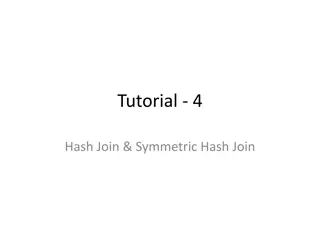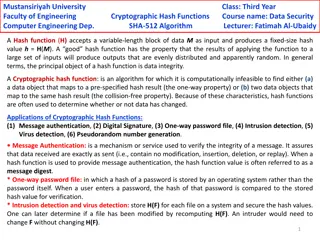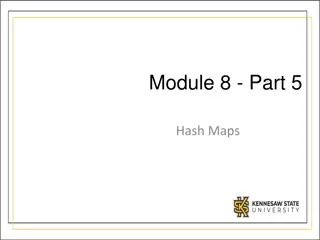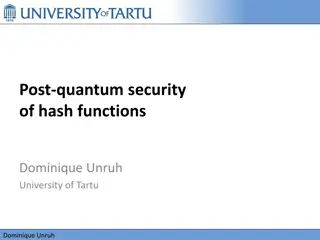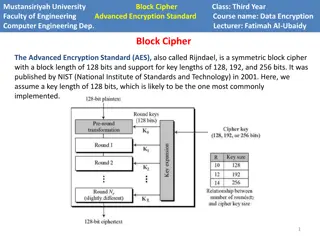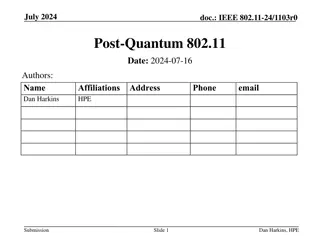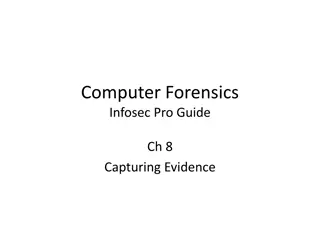Kompetisi Fungsi Hash NIST (SHA-3): Proses Pemilihan Finalis dan Detail Desain
Seperti sejarah AES, National Institute of Standards and Technology (NIST) menyelenggarakan kompetisi terbuka untuk mengembangkan fungsi hash baru yang disebut SHA-3. Kompetisi ini diadakan dari tahun 2007 hingga Oktober 2012. Proses pemilihan terdiri dari 2 putaran dan babak final dengan total 64 submission. Lima finalis terpilih yaitu BLAKE, Grstl, JH, Keccak, dan Skein. Setiap finalis memiliki detail desain yang berbeda-beda, seperti ukuran digest, jumlah putaran, dan penjelasan desainnya.
Download Presentation

Please find below an Image/Link to download the presentation.
The content on the website is provided AS IS for your information and personal use only. It may not be sold, licensed, or shared on other websites without obtaining consent from the author. Download presentation by click this link. If you encounter any issues during the download, it is possible that the publisher has removed the file from their server.
E N D
Presentation Transcript
Kompetisi Fungsi Hash NIST (SHA-3) Bahan Kuliah IF3058 Kriptografi Rinaldi Munir/Informatika-STEI ITB
Latar Belakang Seperti sejarah AES, National Institute of Standards and Technology (NIST) menyelenggarakan kompetisi terbuka untuk mengembangkan fungsi hash yang baru, bernama SHA-3 SHA-3 menjadi komplementer SHA-1 dan SHA-2 Kompetisi diumumkan pada tahun 2007 dan berakhir pada Oktober 2012 dengan memilih pemenang. Rinaldi Munir/Informatika-STEI ITB
Proses Pemilihan Proses pemilihan terdiri dari 2 putaran dan final Jumlah submission adalah 64 rancangan fungsi hash. Putaran pertama (penyisihan): dipilih 51 submission Putaran kedua (semi final): dipilih 14 submission Babak final: 5 finalis Rinaldi Munir/Informatika-STEI ITB
Finalis 1. BLAKE 2. Gr stl 3. JH 4. Keccak 5. Skein Rinaldi Munir/Informatika-STEI ITB
BLAKE Designers: Jean-Philippe Aumasson, Luca Henzen, Willi Meier, Raphael C.-W. Phan Detail: Digest sizes 224, 256, 384 or 512 bits Rounds 14 or 16 Rinaldi Munir/Informatika-STEI ITB
Grstl Designers: Praveen Gauravaram, Lars Knudsen, Krystian Matusiewicz, Florian Mendel, Christian Rechberger, Martin Schl ffer, and S ren S. Thomsen Detail: Digest sizes 256 and 512 Rinaldi Munir/Informatika-STEI ITB
JH Designers: Hongjun Wu Detail: Digest sizes 224, 256, 384, 512 Rinaldi Munir/Informatika-STEI ITB
Keccak Designers: Guido Breton, Joan Daemen, Micha l Peeters and Gilles Van Assche. Detail: Digest sizes arbitrary Rinaldi Munir/Informatika-STEI ITB
SKEIN Designers: Bruce Schneier, Stefan Lucks, Niels Ferguson, Doug Whiting, Mihir Bellare, Tadayoshi Kohno, Jon Callas and Jesse Walker. Detail: Digest sizes arbitrary Rounds: 72 (256 & 512 block size), 80 (1024 block size) Rinaldi Munir/Informatika-STEI ITB
dan pemenangnya adalah Keccak Guido Breton, Joan Daemen, Micha l Peeters and Gilles Van Assche. Keccak terpilih sebagai SHA-3 Rinaldi Munir/Informatika-STEI ITB
Kriteria Penilaian oleh NIST NIST noted some factors that figured into its selection as it announced the finalists:[11] Performance: "A couple of algorithms were wounded or eliminated by very large [hardware gate] area requirement it seemed that the area they required precluded their use in too much of the potential application space. Security: "We preferred to be conservative about security, and in some cases did not select algorithms with exceptional performance, largely because something about them made us 'nervous,' even though we knew of no clear attack against the full algorithm. Analysis: "NIST eliminated several algorithms because of the extent of their second-round tweaks or because of a relative lack of reported cryptanalysis either tended to create the suspicion that the design might not yet be fully tested and mature. Diversity: The finalists included hashes based on different modes of operation, including the HAIFA and sponge function constructions, and with different internal structures, including ones based on AES, bitslicing, and alternating XOR with addition. Rinaldi Munir/Informatika-STEI ITB
Sekilas Keccak Nama 'Keccak' berasal dari 'Kecak', tarian Bali. Keccak berbeda dari finalis SHA3 lainnya dalam hal menggunakan konstruksi 'spons' (sponge construction). Jika desain lainnya bergantung pada 'fungsi kompresi, Keccak menggunakan fungsi non-kompresi untuk menyerap dan kemudian 'memeras' digest singkat. Ini jelas apakah desain ini lebih baik atau lebih buruk daripada pendekatan yang ada. Tapi itu berbeda. NIST merasa bahwa dalam kasus ini, yang berbeda adalah lebih baik. Rinaldi Munir/Informatika-STEI ITB
Konstruksi spons Rinaldi Munir/Informatika-STEI ITB
First, the input string is padded with a reversible padding rule and cut into blocks of r bits. Then the b bits of the state are initialized to zero and the sponge construction proceeds in two phases: (a) In the absorbing phase, the r-bit input blocks are XORed into the first r bits of the state, interleaved with applications of the function f. When all input blocks are processed, the sponge construction switches to the squeezing phase. (b) In the squeezing phase, the first r bits of the state are returned as output blocks, interleaved with applications of the function f. The number of output blocks is chosen at will by the user. The last c bits of the state are never directly affected by the input blocks and are never output during the squeezing phase. Sumber: http://sponge.noekeon.org/ Rinaldi Munir/Informatika-STEI ITB
Keccak[r,c](M) { Initialization and padding S[x,y] = 0, forall (x,y) in (0 4,0 4) P = M || 0x01 || 0x00 || || 0x00 P = P xor (0x00 || || 0x00 || 0x80) Absorbing phase forall block Pi in P S[x,y] = S[x,y] xor Pi[x+5*y], forall (x,y) such that x+5*y < r/w S = Keccak-f[r+c](S) Squeezing phase Z = empty string while output is requested Z = Z || S[x,y], forall (x,y) such that x+5*y < r/w S = Keccak-f[r+c](S) return Z } Rinaldi Munir/Informatika-STEI ITB
Keccak-f[b](A) { forall i in 0 nr-1 A = Round[b](A, RC[i]) return A } Round[b](A,RC) { step C[x] = A[x,0] xor A[x,1] xor A[x,2] xor A[x,3] xor A[x,4], forall x in 0 4 D[x] = C[x-1] xor rot(C[x+1],1), forall x in 0 4 A[x,y] = A[x,y] xor D[x], forall (x,y) in (0 4,0 4) and steps B[y,2*x+3*y] = rot(A[x,y], r[x,y]), forall (x,y) in (0 4,0 4) step A[x,y] = B[x,y] xor ((not B[x+1,y]) and B[x+2,y]), forall (x,y) in (0 4,0 4) step A[0,0] = A[0,0] xor RC return A } Rinaldi Munir/Informatika-STEI ITB
Spesifikasi Keccak (termasuk source code) dapat dilihat di: http://keccak.noekeon.org/specs_summary.html Rinaldi Munir/Informatika-STEI ITB


